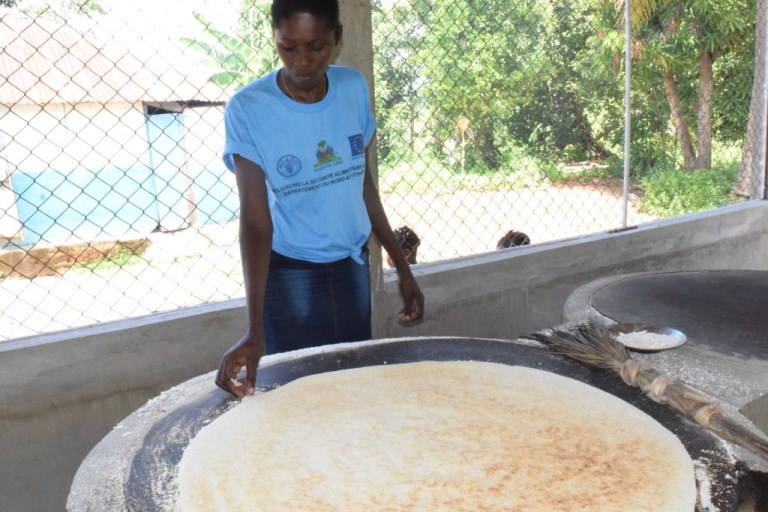Promoting Rural Youth Employment for Poverty Reduction in Haiti

This post is also available in:
This post is also available in:
![]() Português (Portuguese (Brazil))
Português (Portuguese (Brazil))
Haiti is a resilient society whose rural communities, have developed coping mechanisms in response to a long history of underdevelopment and political instability. In addition, the country’s religious, cultural, and artistic life is highly diverse and vibrant. These should be the groundings to draw upon in breaking the poverty trap in the country. Unfortunately, Haiti is also plagued by inequality, economic decline, unemployment and poor governance.
The country faces important challenges to generate faster growth and fight poverty. It has experienced a deteriorating economic dynamic due to the devaluation of the national currency and high inflation rates in recent years. Economic growth continued to decelerate from 2.8 percent in fiscal year 2014, to 1.2 percent in 2015 and 2016, and is expected decrease further to -0.6 percent in 2017 (World Bank).
Employment opportunities are scarce and less than a fourth of the working age population has a stable income. The informal sector remains a major employer but provides little job security to its workers. The proportion of workers having an insecure job is significant with 35 percent of workers self-employed and 8 percent working in family businesses. Wages are not enough to enable individuals to meet their own basic needs, as 45 percent of workers live on less than USD 1.25 a day. Women are significantly disadvantaged in the labor market; they are 20 percentage points more likely than men to be unemployed.
Analyzing the social diversity, assets, and livelihoods together with power, governance and institutions – the main dimensions of development – it looks that the Haiti’s poverty trap seems to derive from a couple of main factors:
a) Demographic and socioeconomic factors at individual and household levels – the population growth rate is highest in the cities. Port-au-Prince for example, scores highly on demographic factors, including a very young population profile, high population turnover and poverty. Rural people continue to be attracted to urban areas by higher levels of infrastructure, services and greater access to formal and skilled jobs.
b) The State’s institutional capacity to provide public goods and manage social risks – institutions are vital for social and economic development and are crucial for state building as they have the potential to mitigate the risk factors deriving from the socioeconomic and demographic context. The Haitian state, however and despite all the efforts made by the Government, has only a limited capacity to create conditions for economic growth and poverty reduction.
Breaking Haiti’s poverty trap require a capable national political leadership that is committed to the consolidation of democratic institutions and processes. However, in a context of very difficult socioeconomic conditions, high social risks, weak state institutions and extremely limited budget resources, Haiti’s leaders face enormous challenges. In addition, employment creation is a controversial issue in Haiti, and many believe the salvation of the country lies in “going back to agriculture” as farming can create food security, food sovereignty, employment and perhaps even export income.
The Role of the Rural Sector
Historically, agriculture has been an engine of economic development, providing the food, feed, fiber and fuel needed to create a more diversified products and services in other sectors. In many developing countries, agriculture continues to be the backbone of rural livelihoods and, in some cases, a major contributor to the GDP. This assumption fully applies to Haiti where livelihoods are determined by three key factors:
a) assets, which can be sold to smooth out consumption when the household is adversely affected by a natural disaster or economic crash;
b) access to labor markets, infrastructure, and services that can improve the opportunities for income generation; and
c) migration as a coping mechanism to face poverty and lack of opportunities.
Poor households have very little or no access to many of these livelihood-improving factors. In Haiti, living in rural areas does not increase the probability of being poor (as it happens in many developing countries) and people engaged in agriculture are not more likely to fail under the poverty line than those engaged in services and industry. In both rural and urban areas, migration and education are the factors that most reduce the likelihood of falling into poverty.
With an area of 27,750 km2, Haiti is the third most important country in terms of population in the Caribbean. The country made up of ten departments with a total population of approximately 11 million inhabitants of which about 48% living in rural areas. A large share of the labor force is engaged in low-return agricultural activities and many of poorly educated rural youth with few skills and poor job prospects cannot thrive due to lack of support in terms of policies, infrastructure, inputs and investment.
Agriculture provides 50 percent of jobs in the country and accounts for 25 percent of the GDP. For most of the 1 million smallholder farmers, low agricultural productivity and land tenure insecurity are significant problems. Farms are small – averaging less than 1 hectare each – and increasing population puts pressure on farm size. The Government has put increased agricultural production and local purchases of domestic production very high on its agenda.
Rural youth represent both a challenge to, and an opportunity for reducing rural poverty. To overcome this challenge and seize this opportunity, government efforts to generate decent employment opportunities for young people must be encouraged and supported. Indeed, sustainable poverty reduction and rural economic development will only be achieved when national enabling environments allow and empower young people to achieve their full potential.
What Could be Done?
Labor is poor people’s most abundant asset and it accounts for most of their total income. The poor however, is constrained in the use of this asset due to the lack of jobs, low wages, and wage discrimination, especially for women. Many Haitian workers are poor despite working full time, and thus it is important to raise the quality and quantity of jobs. The challenge of job-creation, therefore, is to increase worker productivity and increase opportunities in the labor market for competitive wages, to lift workers and their households out of poverty.
Unemployment, together with food insecurity, climate change and natural disasters, is a major issue that often pushes people to migrate. Pro-poor growth agricultural policies can contribute to food security, reduce food production costs and stimulate non-farm economic activities and, through its linkages with the industrial and service sectors, create employment. Agriculture cannot play this dynamic, wealth-creating role without an enabling policy environment, adequate institutions, and sufficient, well-targeted public and private investment.
The development of the rural sector must be part of a much larger process of social, economic and political development. Good governance and political stability are among the prerequisites for job-rich, pro-poor sustainable growth to occur. The promotion of policies and investments that support the creation of decent employment opportunities in rural areas is crucial to improve the livelihood of the Haiti’s poor. Having inadequate access to productive resources, financial credit and training exacerbates the lack of economic opportunities.
To meet the UN Sustainable Development Goals and eradicate poverty and hunger by 2030, donors and development partners must support countries in the development of strategies and programs that create more and better jobs, especially for women and youth, stimulating both farm and non-farm economies.
FAO and IFAD are promoting a complementary set of awareness-raising, policy assistance, capacity development and providing technical assistance to support the Government of six Caribbean countries (including Haiti) to develop an enabling environment that meets the multidimensional needs of the rural youth. The actions in place are aimed at:
- Facilitating a common sub-regional policy and program development process with governments, stakeholders and partners, including rural youth and farmer organizations for rural youth employment;
- Developing and promoting evidence-based knowledge platforms as the basis for information sharing, training and capacity building on rural youth employment generation and entrepreneurship, and
- Building capacity to assist access to employment and facilitating the adoption of innovations and best practices for enterprise development among young women and men.
Some Conclusions
A healthy and dynamic agricultural sector is an important foundation of development, generating strong linkages to other economic sectors. Rural livelihoods are enhanced through effective participation of rural people and rural communities in the management of their own social, economic and environmental objectives by empowering people in rural areas, particularly women and youth, including through local organizations such as associations, cooperatives and by applying the bottom-up approach.
Close economic integration of rural areas with neighboring urban areas and the creation of rural off-farm employment can narrow rural-urban disparities, expand opportunities and encourage the retention of skilled people, including youth, in rural areas. There is considerable potential for rural job creation not only in farming, agro-processing and rural industry but also in building rural infrastructures, sustainable management of natural resources, waste and residues.
In Haiti, rural communities are still facing the challenges related to access to basic services and economic opportunities. Investments in environmental protection, rural infrastructure and in rural health and education are critical to sustainable rural development. Investments must also be linked to the potential to raise productivity and income.
There are several actions that, if applied simultaneously and with the same beneficiaries, they can lead to increased production and productivity, generate income and strengthen local rural economies in Haiti. For example:
– Build social capital and resilience in rural communities (empower women and small-scale farmers through participation, promote equitable access to land, water, financial resources and technologies by women and other vulnerable groups, support and promote efforts to harmonize modern technologies with traditional knowledge for sustainable rural development, provide access to credit and other mechanisms as well as resources for farm-based activities, promote and scale up labour-intensive recovery activities in addition to capital-intensive programmes, support training and capacity building of rural communities to effectively implement climate change adaptation programmes at the local level, etc.)
– Capacity building for rural people (strengthen rural health-care facilities and capacities, train and increase the number of health and nutrition professionals, develop nutrition educational programmes for rural communities, ensure provision of primary education and access to secondary and tertiary educational opportunities as well as vocational and entrepreneurship training including proactive and market-related elements for youth, encourage rural communities’ participation in decision-making, improve access to information, education, extension services and learning resources, knowledge and training to support sustainable development planning and decision-making, etc.)
– Invest in essential infrastructure and services for rural communities (increase public and private investments in infrastructure in rural areas including roads, transport systems, storage, market facilities, livestock facilities, irrigation systems, water supply, sanitation services, electrification facilities, extension services, information and communications networks, etc.)
– Stimulate the creation of new jobs and income opportunities in rural areas (support rural diversification, provide appropriate land-use frameworks to support the establishment of agricultural activities and both farm and non-farm services, provide entrepreneurial training, credit and other support to off-farm and other non-farm activities, strengthen links between agriculture and other sectors of the rural economy, add value to agricultural products locally to generate additional income, increase access to markets, affordable financial and business advisory services, etc.)
– Ensure environmental sustainability in rural areas (encourage the use of land resources in a sustainable manner to prevent land degradation and promote sustainable natural resources use and management).
Development and poverty reduction will not be possible without a focus on strengthening the government’s capacity to provide basic public goods to its population. Good leadership is the most important factor for breaking out of Haiti’s poverty trap and it cannot be provided by donors but only by Haitians themselves.








































































